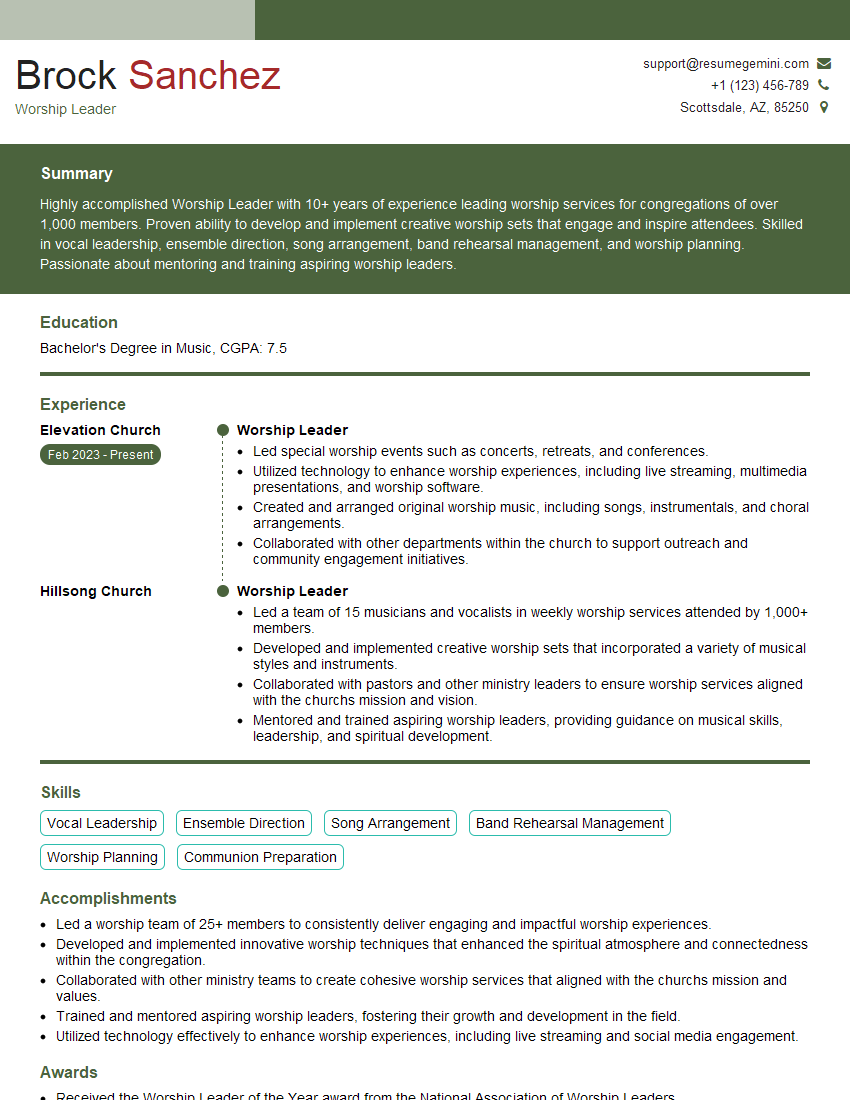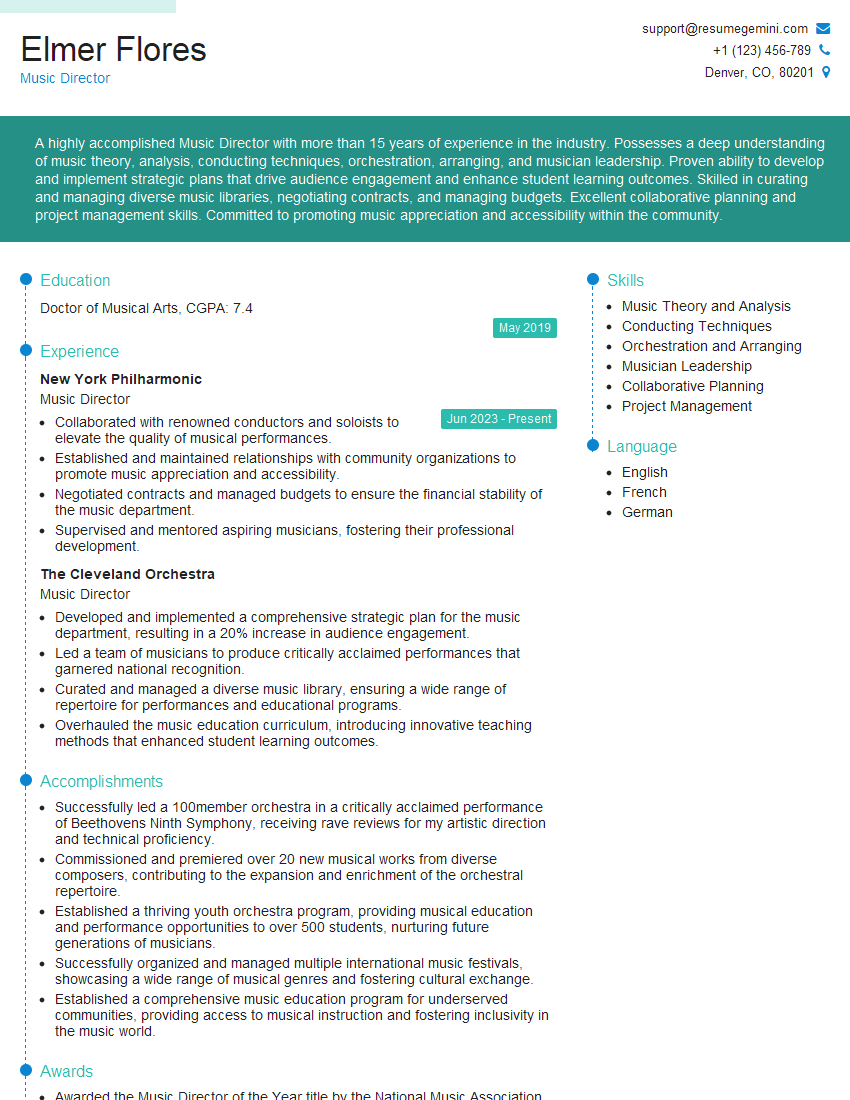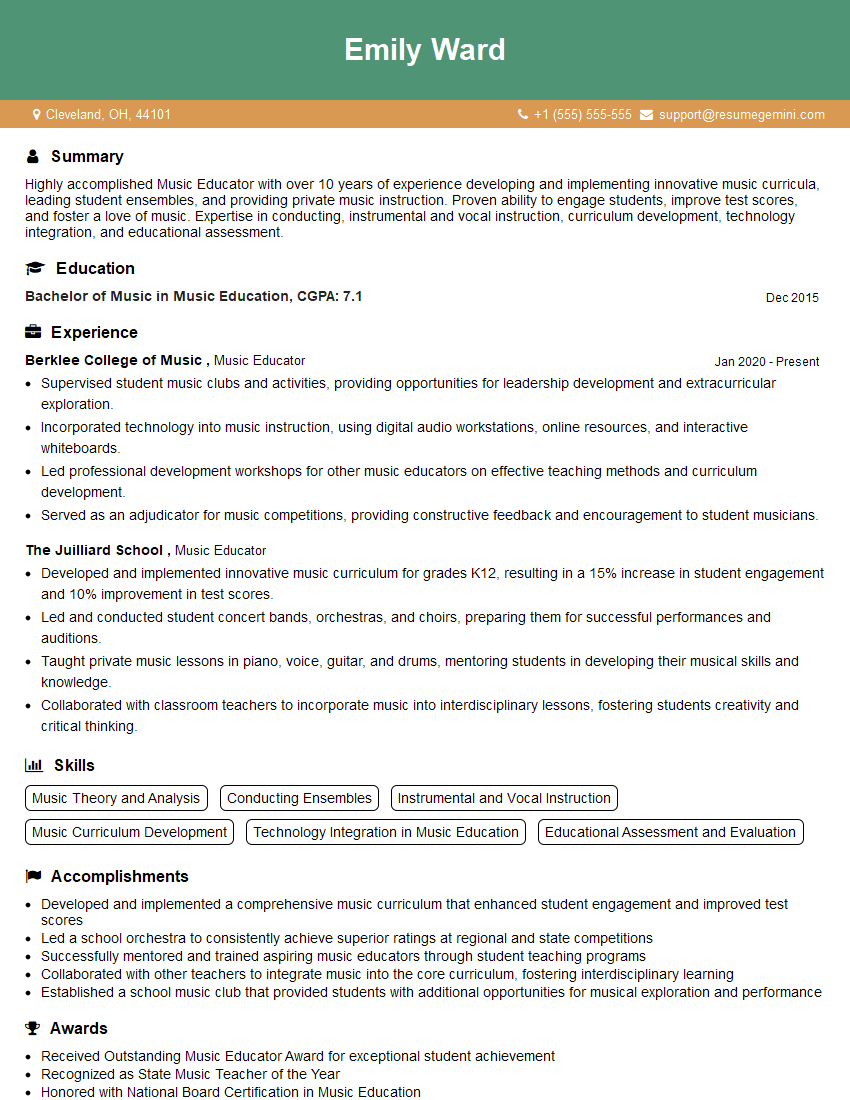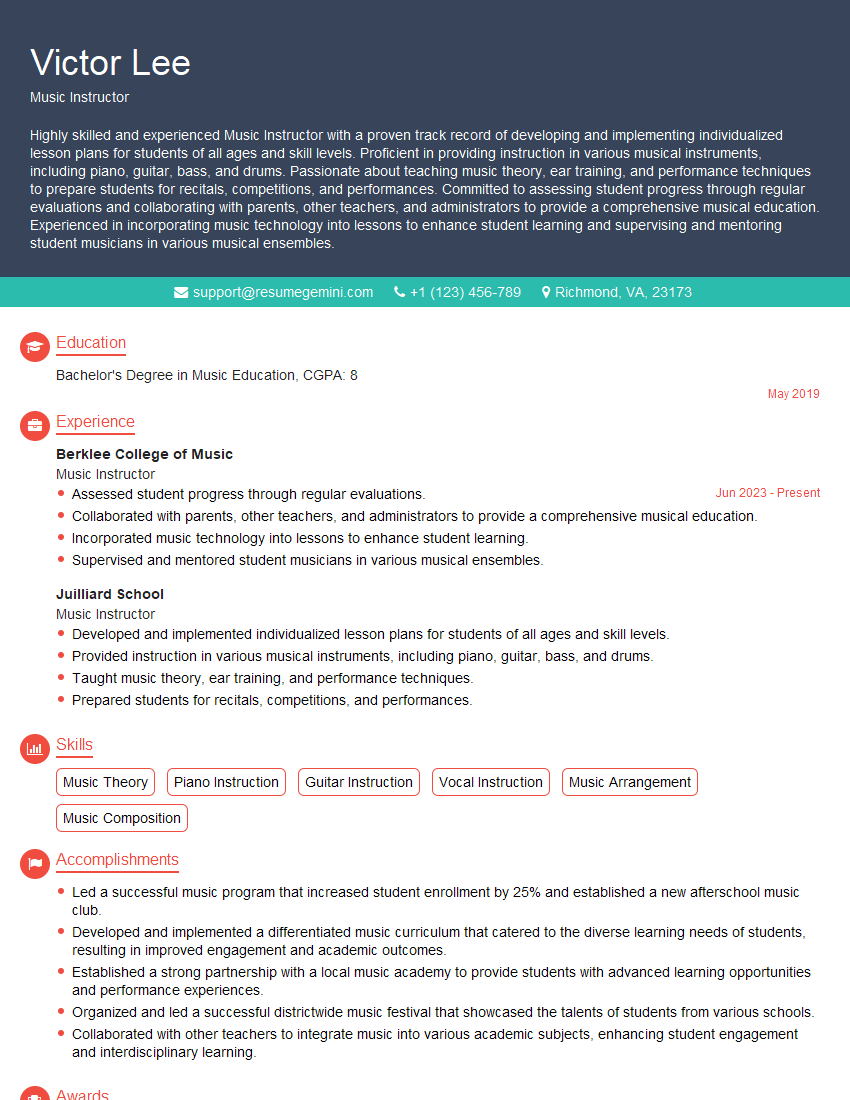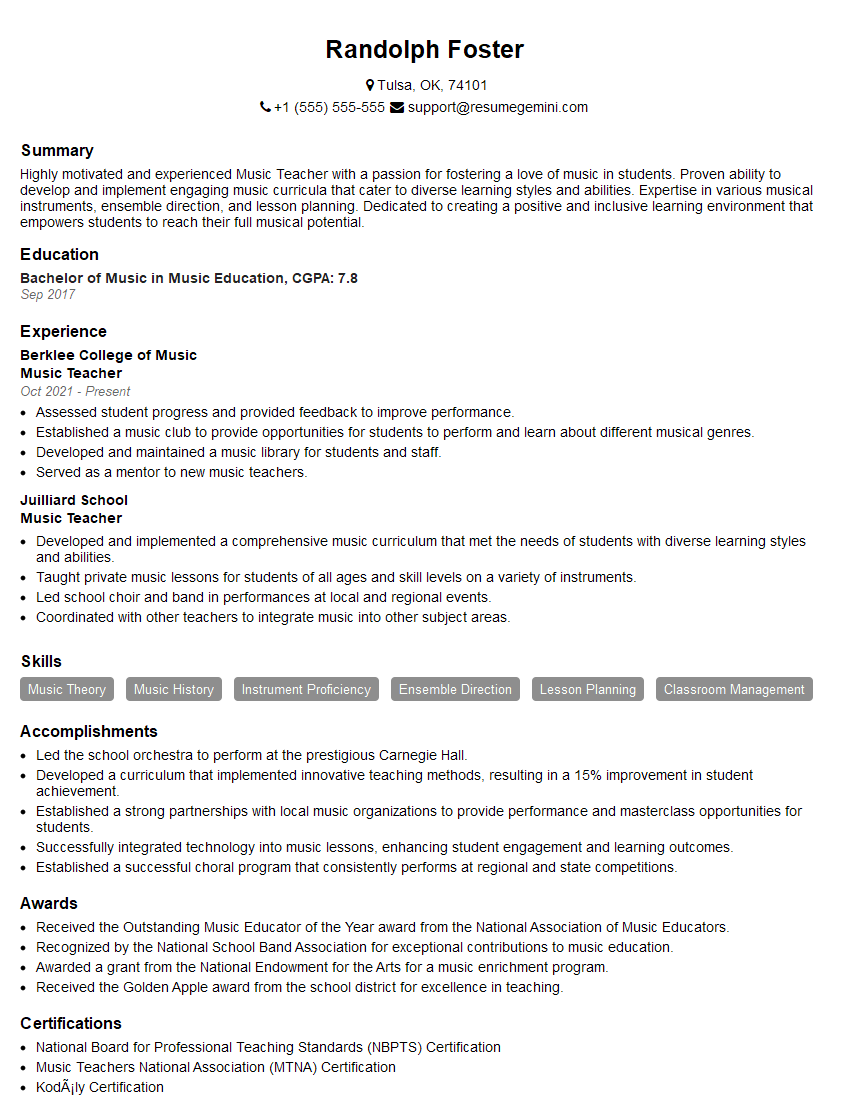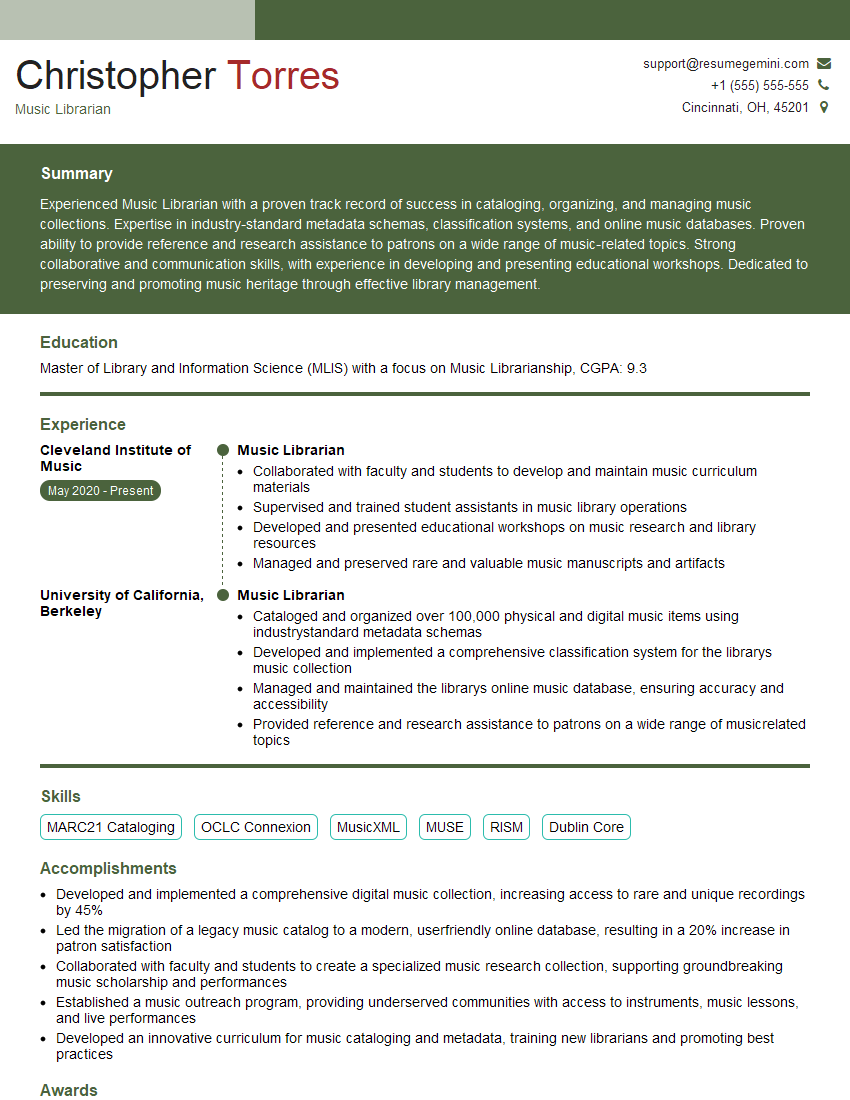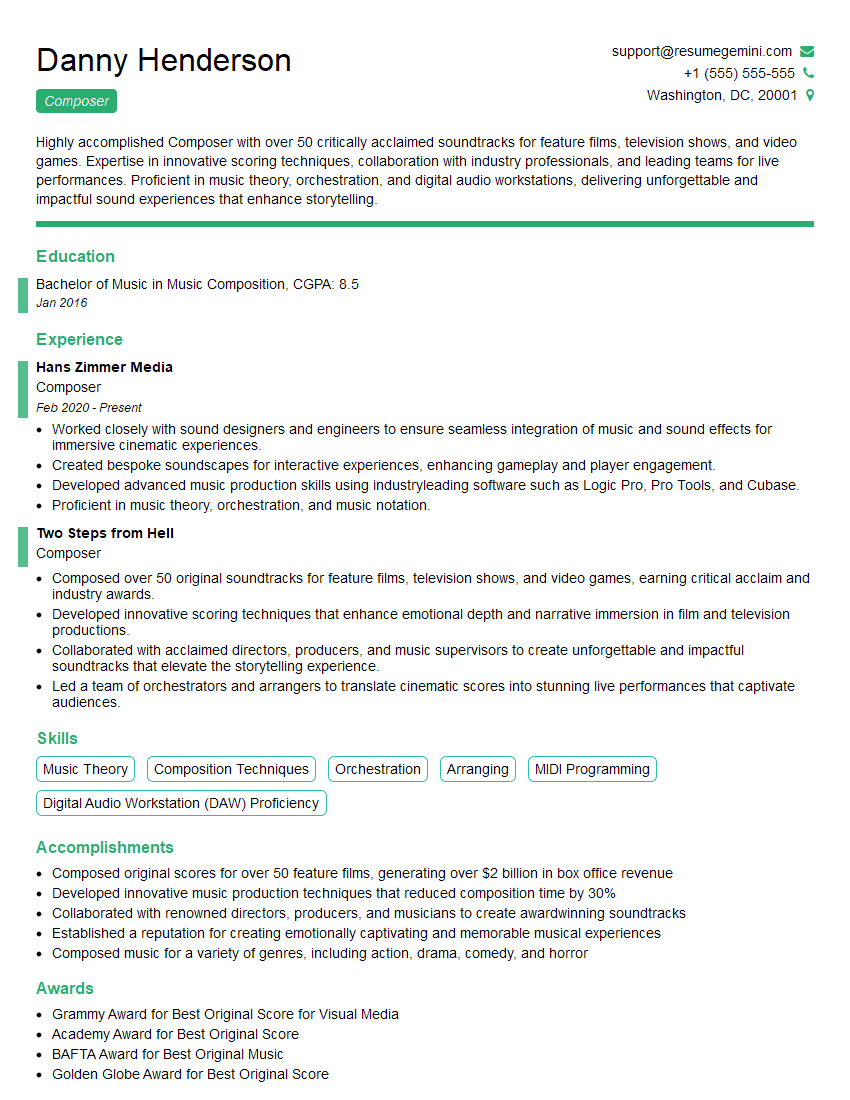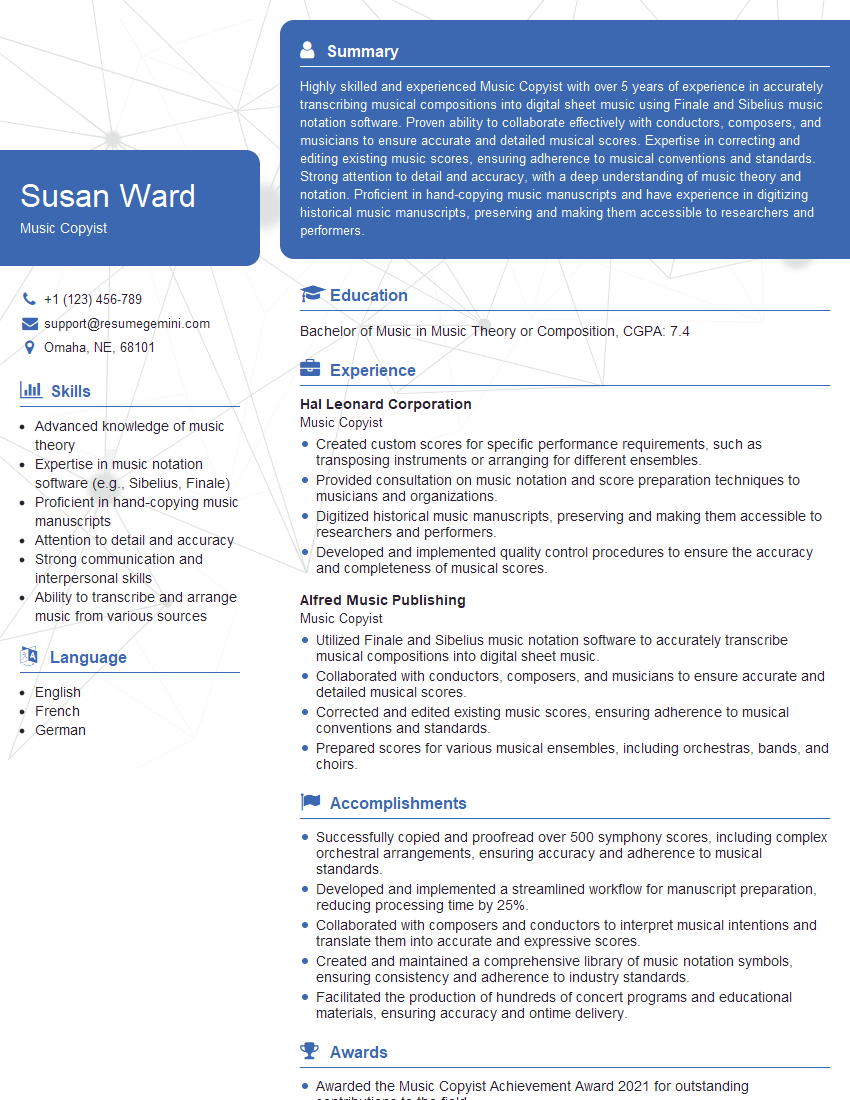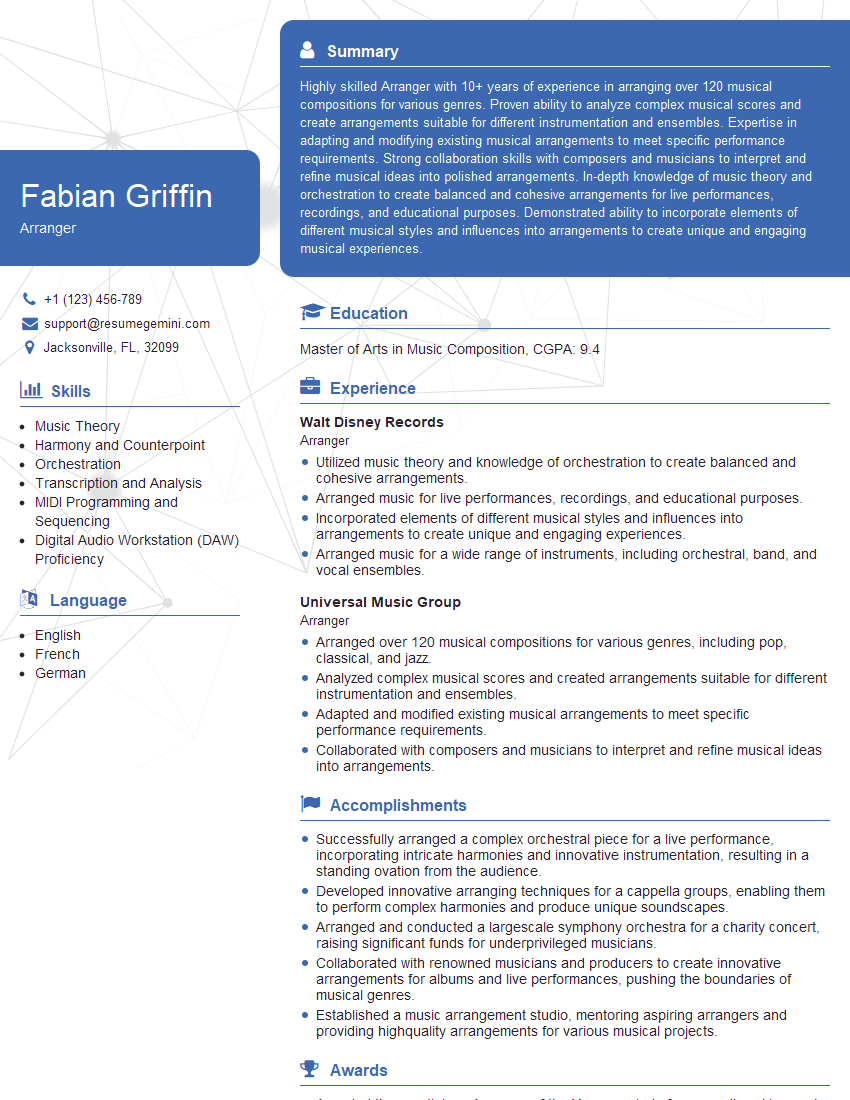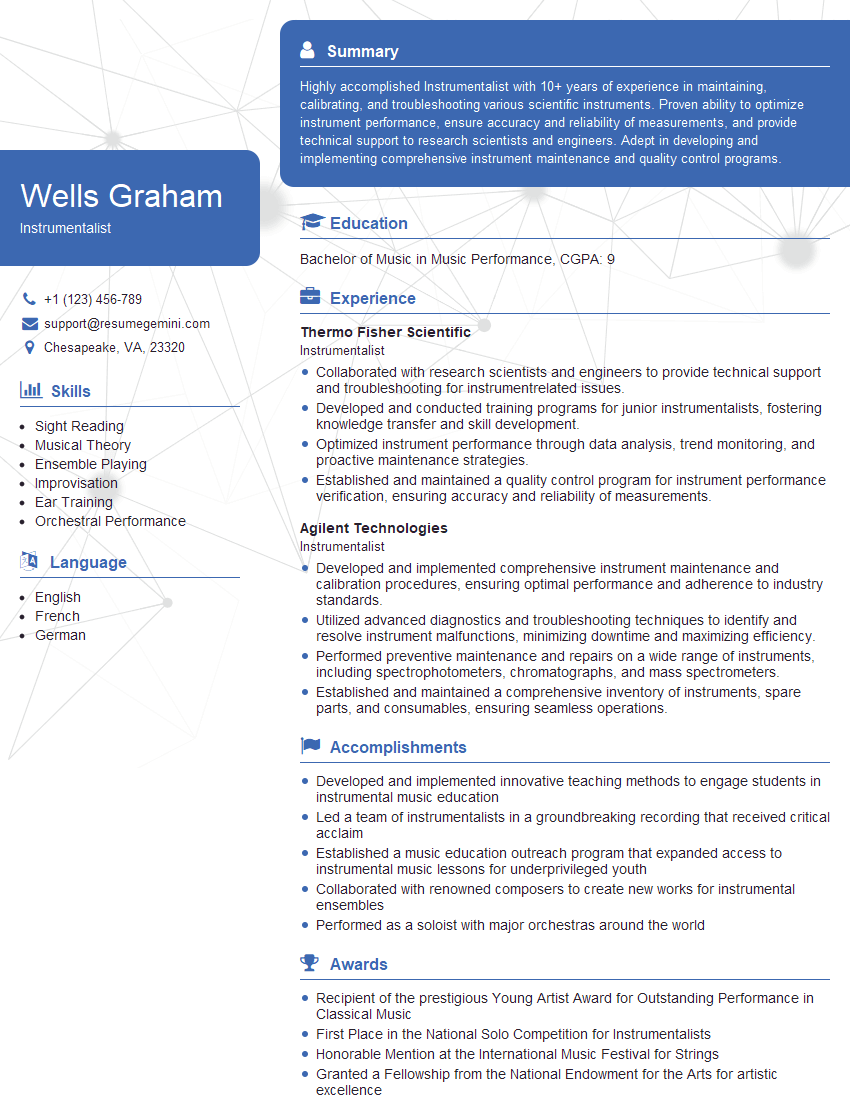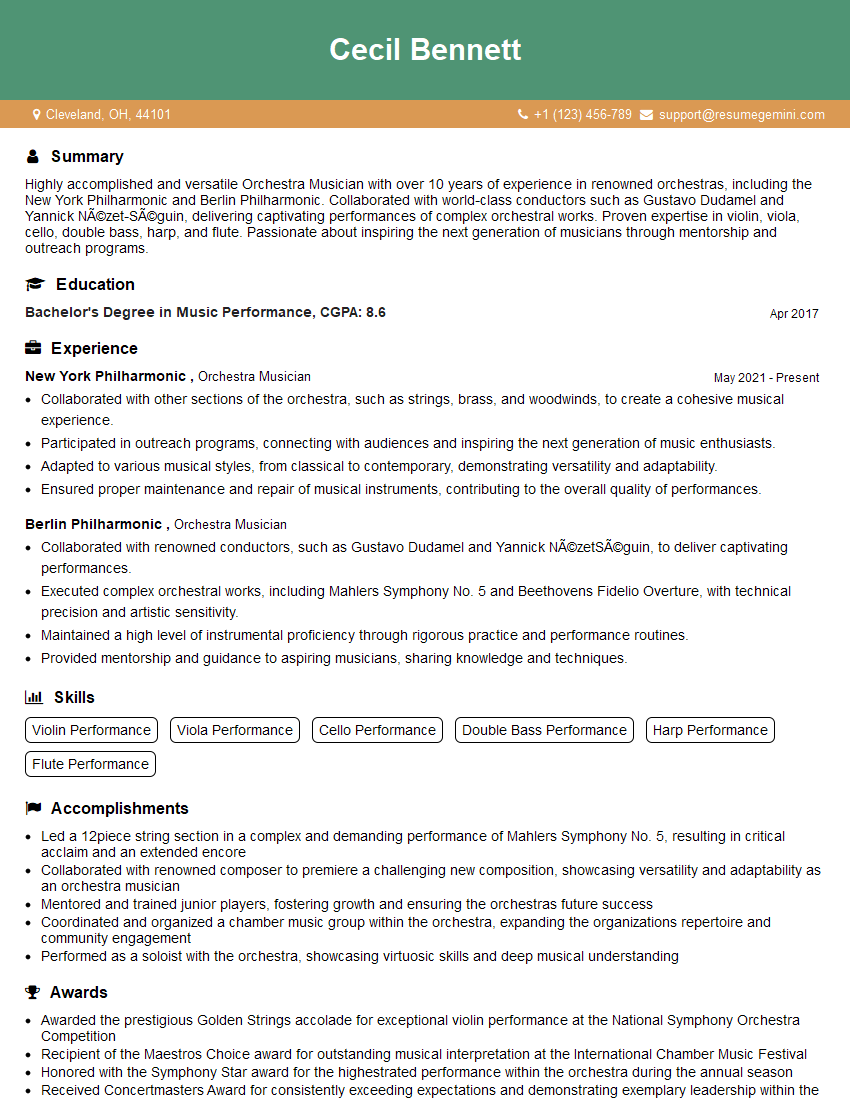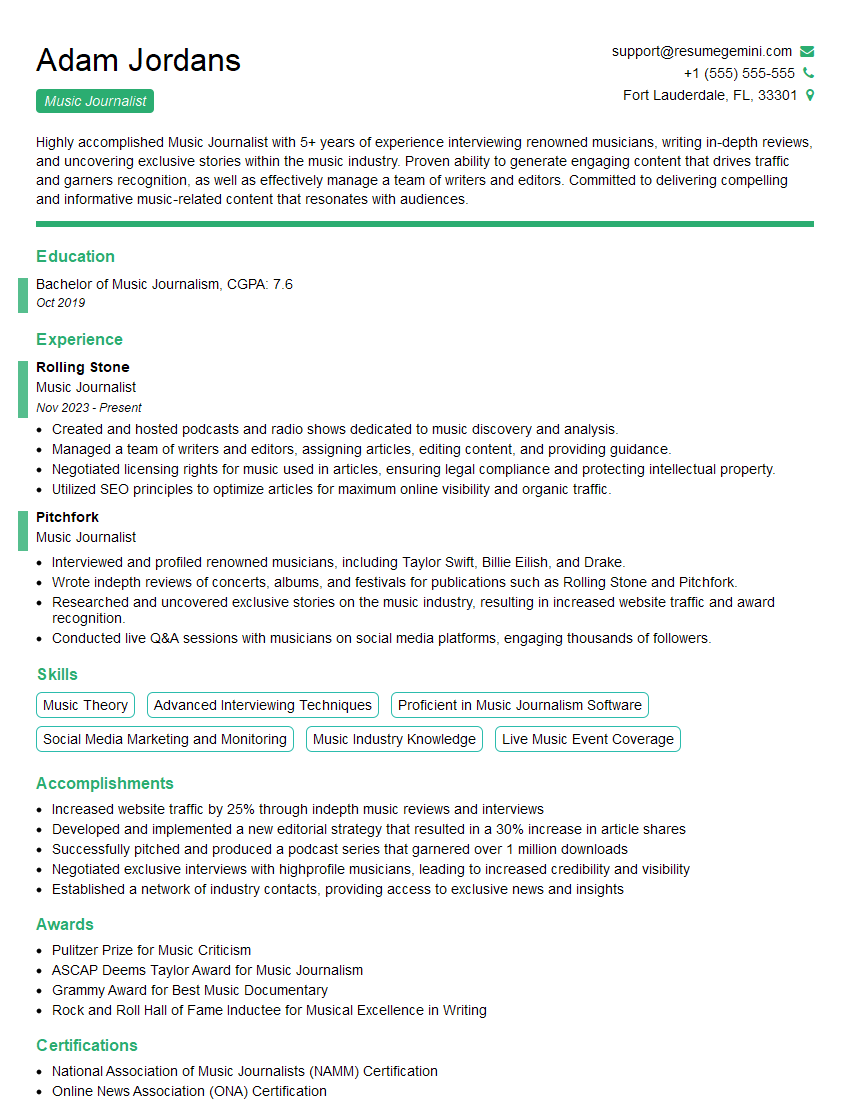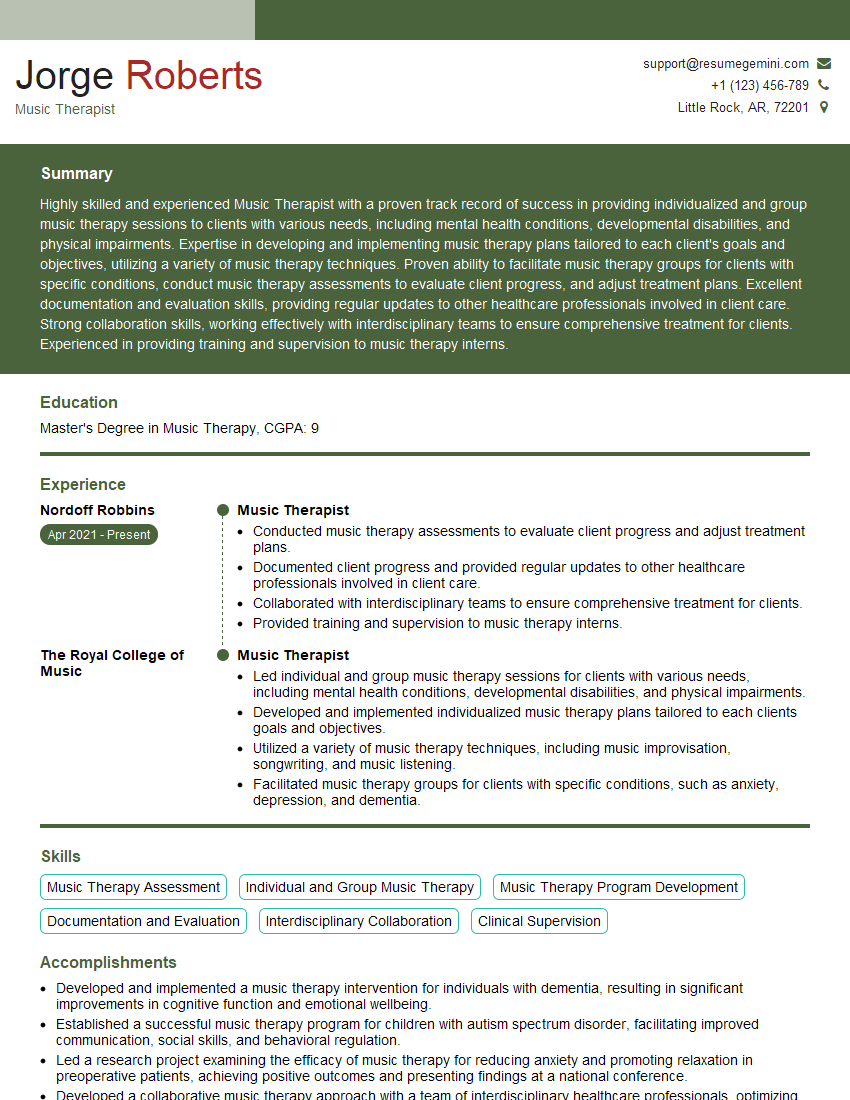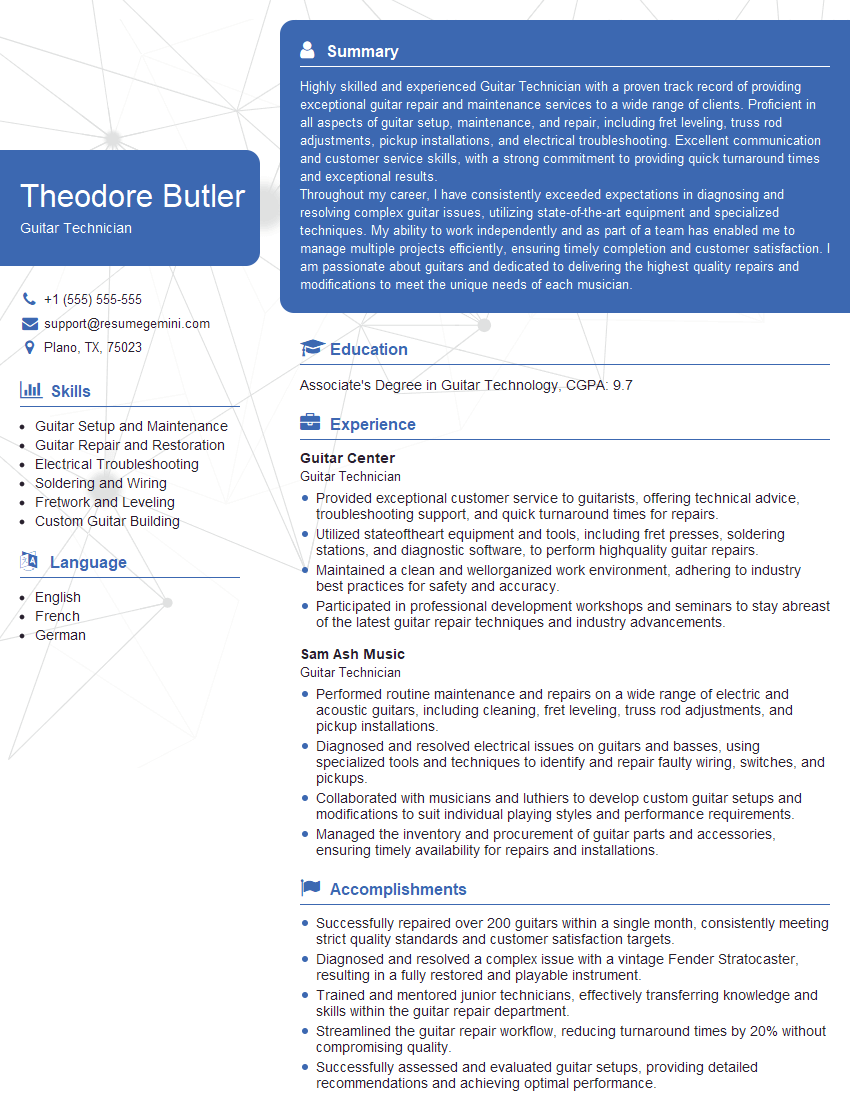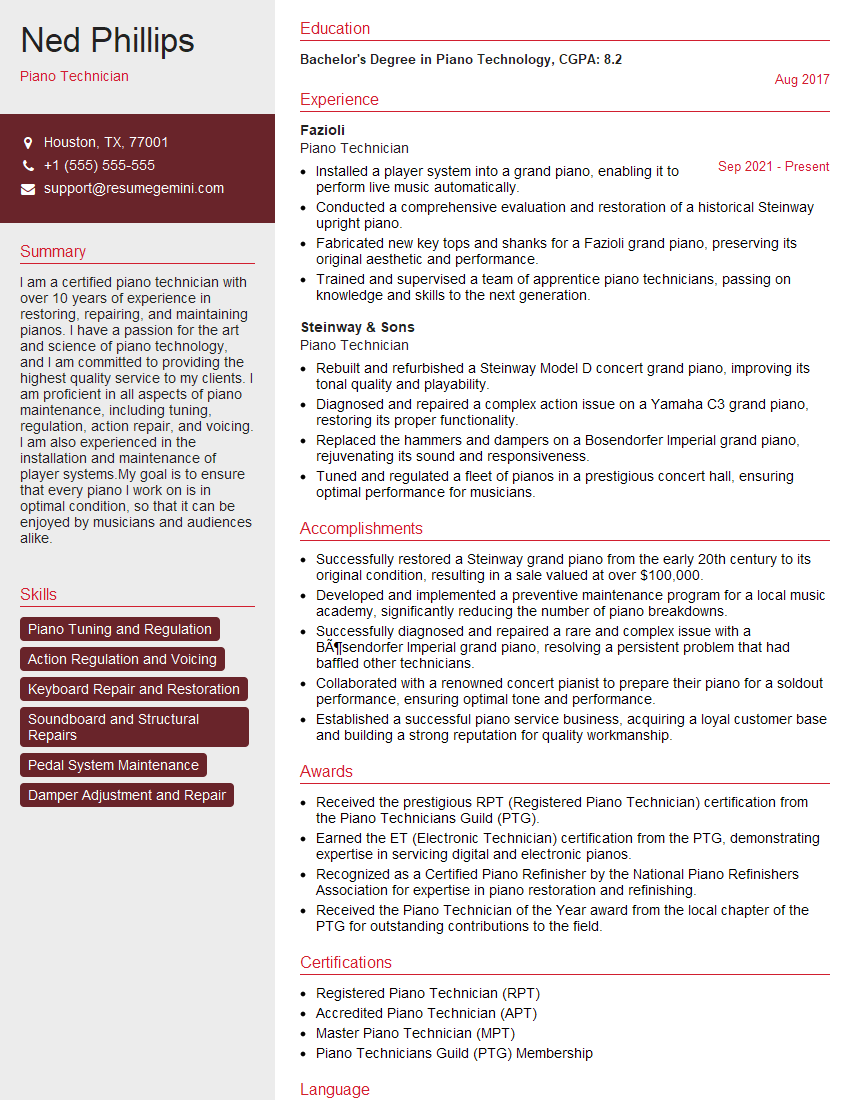Preparation is the key to success in any interview. In this post, we’ll explore crucial Instrument Proficiency (Guitar, Bass, Drums, Piano, etc.) interview questions and equip you with strategies to craft impactful answers. Whether you’re a beginner or a pro, these tips will elevate your preparation.
Questions Asked in Instrument Proficiency (Guitar, Bass, Drums, Piano, etc.) Interview
Q 1. Describe your experience with various musical styles.
My musical journey has spanned a diverse range of styles, from the intricate harmonies of classical music to the raw energy of rock and the soulful grooves of funk. I’ve actively performed and recorded in various genres, including:
- Classical: Extensive experience playing Baroque and Romantic era pieces on both guitar and piano, focusing on technical precision and nuanced expression.
- Jazz: Proficient in improvisation and chord voicings, with a strong understanding of jazz harmony and rhythm. I’ve participated in several jazz combos and big band performances, honing my skills in soloing and ensemble playing.
- Rock/Pop: Comfortable with various rock subgenres, from blues-rock to alternative rock. My experience extends to recording sessions and live performances, emphasizing powerful rhythm and dynamic interplay.
- Funk/R&B: Deep understanding of rhythmic complexity and groove-based playing. I’ve worked with various bands incorporating funk and R&B elements, emphasizing syncopation and feel.
This broad experience allows me to adapt quickly to new musical contexts and contribute creatively to diverse projects.
Q 2. Explain your approach to learning a new instrument.
My approach to learning a new instrument is systematic and focused on building a strong foundation. It involves several key steps:
- Understanding the Instrument’s Mechanics: I begin by thoroughly understanding the instrument’s construction, tuning, and basic playing techniques. This includes understanding the physical relationship between actions and sound production.
- Fundamental Skills: I dedicate significant time to mastering fundamental skills like posture, hand positioning, and basic scales and chords. I might use method books or online resources tailored to the specific instrument.
- Progressive Learning: I progress gradually, tackling increasingly complex techniques and musical pieces. I often start with simple exercises, gradually increasing the difficulty as my skills improve. I set achievable goals and celebrate small victories along the way.
- Active Listening & Analysis: I actively listen to music played on the new instrument, analyze its techniques, and try to emulate the sounds and styles. This helps me understand the instrument’s expressive capabilities.
- Practice Routine: I establish a consistent practice routine that incorporates technical exercises, musical pieces, and improvisation. Regularity is key, even if it’s just for short periods.
For example, when I picked up the bass, I started with basic finger exercises, then moved onto simple blues scales and bass lines before tackling more complex grooves and song arrangements.
Q 3. What software or DAWs are you proficient in?
I am proficient in several Digital Audio Workstations (DAWs) and music software including:
- Logic Pro X: Extensive experience in recording, editing, mixing, and mastering. I’m comfortable with all aspects of the workflow, including MIDI sequencing and virtual instrument usage.
- Ableton Live: Proficient in its loop-based workflow, ideal for electronic music production and live performance. I frequently use this for improvisation and experimental music projects.
- GarageBand: A user-friendly DAW, excellent for quick sketches and basic recording projects. It’s a good tool for initial ideas and early stage production.
- Sibelius (Notation Software): I utilize Sibelius for creating and editing musical scores, which is invaluable for arranging and studying complex musical pieces.
My proficiency extends to various virtual instruments and effects plugins, allowing me to create high-quality recordings and productions.
Q 4. How do you handle performance anxiety?
Performance anxiety is a common challenge for musicians. My approach is multifaceted:
- Preparation: Thorough preparation is paramount. Knowing the music inside and out dramatically reduces anxiety. This includes practicing extensively in various settings, simulating performance conditions.
- Visualization: I use visualization techniques to mentally rehearse successful performances. This helps build confidence and reduces the fear of the unknown.
- Breathing Exercises: Deep breathing exercises help calm nerves and reduce physical tension before a performance.
- Positive Self-Talk: Replacing negative thoughts with positive affirmations can significantly improve confidence and mindset.
- Experience: Consistent performance experience gradually builds resilience and reduces anxiety over time. The more you perform, the more comfortable you become.
For instance, before a crucial gig, I’ll run through my setlist multiple times, focusing on sections where I’m slightly less confident. I also utilize deep breathing exercises backstage to centre myself.
Q 5. Describe your experience with sight-reading music.
Sight-reading is the ability to interpret and play music from a score without prior preparation. My sight-reading skills are well-developed, particularly for piano and guitar. My approach involves:
- Understanding Rhythmic Notation: I can quickly identify note values and rhythmic patterns, allowing me to establish a solid rhythmic foundation.
- Key Signatures and Clefs: I have a strong understanding of key signatures and different clefs, allowing me to easily navigate the music.
- Chord Recognition: I can quickly recognize chord progressions and voicings, which helps me anticipate harmonic changes.
- Practice: Regular sight-reading practice is essential. I dedicate time to reading new pieces, focusing on accuracy and fluency.
While perfect sight-reading is rare, I can often read and play relatively simple pieces accurately and expressively at first sight. More complex pieces require some preliminary analysis and practice before achieving fluent performance.
Q 6. Explain your understanding of music theory (scales, chords, rhythms).
My understanding of music theory is comprehensive and forms the foundation of my musical abilities. This includes:
- Scales: I’m familiar with various scales (major, minor, modes, etc.), understanding their construction, intervals, and characteristic sounds. I can easily transpose scales to different keys.
- Chords: I have a strong grasp of chord construction, inversions, and functions within a key. I’m comfortable using different chord voicings to create different textures and colors.
- Rhythms: I understand complex rhythmic notations, including syncopation and polyrhythms. I can accurately perform and transcribe rhythms in various time signatures.
- Harmony: I understand harmonic progressions, cadences, and voice leading. I can analyze and create harmonic structures in various styles of music.
This theoretical knowledge informs my playing, enabling me to create meaningful musical phrases, improvise effectively, and analyze musical pieces on a deeper level.
Q 7. How do you approach improvising on your instrument?
Improvisation is a crucial part of my musical practice. My approach involves a combination of theoretical understanding and intuitive expression:
- Scales and Modes: I use scales and modes as a foundation for improvising, selecting appropriate scales based on the harmonic context of the piece.
- Chord Progressions: I understand how chord progressions function, allowing me to create melodic lines that complement and enhance the harmonic structure.
- Rhythmic Variations: I use rhythmic variations to add interest and complexity to my improvisations. This includes syncopation, rhythmic displacement and polyrhythms.
- Listening and Responding: I actively listen to other musicians and respond to their musical ideas, creating a dynamic musical conversation. This is key in ensemble improvisation.
- Ear Training: Strong ear training enables me to quickly identify and respond to changes in harmony and melody, making improvisation more fluid and natural.
For example, when improvising over a blues progression, I might start by playing a blues scale, but then incorporate pentatonic scales and chromatic approaches to create more expressive and interesting melodic phrases.
Q 8. Discuss your experience with recording and mixing music.
My recording and mixing experience spans over a decade, encompassing various genres from rock and jazz to electronic music. I’m proficient in using Digital Audio Workstations (DAWs) such as Pro Tools and Logic Pro X. My process begins with meticulous pre-production, ensuring all instrument parts are well-rehearsed and conceptually sound. During recording, I prioritize capturing a natural and nuanced performance, paying close attention to microphone placement and gain staging. I favor a collaborative approach, working closely with other musicians and engineers to achieve a unified sonic vision. Mixing involves detailed EQ, compression, and reverb adjustments, alongside stereo widening and automation to create a cohesive and engaging listening experience. I frequently utilize plugins from companies like Waves and Universal Audio to achieve specific sonic effects. Mastering is often handled by a specialized engineer, but I have experience in basic mastering techniques such as loudness normalization and limiting. For example, on a recent project, I successfully utilized parallel compression to add punch to the drum bus, significantly improving the track’s dynamic range. This attention to detail ensures a high-quality end product.
Q 9. Describe your experience with different musical ensembles.
My experience with musical ensembles is broad, ranging from small jazz trios to large orchestral settings. I’ve played in various contexts: rock bands, where the focus is on tight rhythmic interplay and powerful dynamics; chamber ensembles, demanding precision, balance, and nuanced interpretations; and larger groups such as orchestras and big bands, emphasizing collaborative listening and responsiveness. I’ve learned to adapt my playing to suit different musical styles and ensemble dynamics. In a jazz trio, for example, I learned the importance of subtle melodic phrasing and harmonic improvisation. In a larger orchestra, focus shifted to precise articulation and adherence to the conductor’s interpretation. These experiences have greatly enhanced my musical versatility and understanding of collective musical expression. This has improved my ability to both lead and follow as needed, contributing significantly to the group dynamic
Q 10. How do you maintain your instrument and equipment?
Maintaining my instruments and equipment is crucial for their longevity and optimal performance. For my guitars, regular cleaning, string changes (every 2-3 weeks depending on use), and fretboard lubrication are essential. I also ensure that my amplifiers are properly ventilated to prevent overheating. My drums receive regular tuning and head replacements, and I keep the hardware clean and lubricated to ensure smooth operation. For my keyboards, I make sure to keep them away from dust and extreme temperatures. Regular servicing is scheduled for all my equipment – I have a technician inspect my instruments for potential problems, ensuring timely repairs and replacements. Think of it as preventive maintenance on a car – consistent care prevents larger problems down the road. I also meticulously document any repairs or maintenance, tracking the date, type of service, and costs incurred. This has helped me budget efficiently for equipment upkeep and make informed decisions on repairs and replacements.
Q 11. What is your preferred method for practicing your instrument?
My preferred method for practicing is structured and goal-oriented, incorporating elements of focused technical exercises and musical exploration. I start with warm-ups, focusing on dexterity and accuracy. Then, I delve into targeted exercises to improve specific techniques, such as scales, arpeggios, and chord progressions. I often use a metronome to develop rhythmic precision and timing. Next, I work on repertoire, focusing on phrasing, dynamics, and musical interpretation. Finally, I dedicate time to improvisational practice, fostering creativity and musical spontaneity. This structured approach ensures a well-rounded practice session, avoiding repetitive drills and maximizing time efficiency. For example, if I’m struggling with a particular fast passage in a piece, I will isolate that section and practice it slowly, gradually increasing the tempo as my accuracy improves. I often record myself to identify areas needing improvement and to track my progress.
Q 12. Explain your approach to composing or arranging music.
My approach to composing and arranging is iterative and intuitive. I typically begin with a core musical idea – a melody, rhythm, or harmonic progression – and develop it through experimentation and refinement. I use a DAW and notation software to organize my ideas and refine the structure. I consider the overall sonic palette and the emotional impact I wish to convey. For example, the choice of instruments and their arrangement plays a significant role. I often employ layering and counterpoint to create depth and complexity. I meticulously craft transitions and ensure a natural flow between sections. Collaboration plays a vital role; I actively seek feedback from others and incorporate suggestions to enhance the overall quality and cohesion of my work. A recent project involved composing a piece for a string quartet, where I had to carefully balance the individual voice lines while maintaining a cohesive ensemble sound. This involved many revisions and adjustments throughout the process to realize my creative vision.
Q 13. How do you adapt your playing style to different musical contexts?
Adapting my playing style to different musical contexts requires versatility and sensitivity. My approach involves understanding the specific musical genre, the ensemble’s dynamics, and the overall aesthetic of the project. For instance, when playing in a heavy metal band, I would employ a powerful and aggressive style, emphasizing distortion and strong rhythmic drive. In a classical setting, my style would be more refined, focusing on precise articulation, dynamics, and expressive phrasing. Similarly, I modify my technique based on the instrument I’m using. Playing bass in a funk band differs significantly from playing bass in a chamber ensemble, requiring alterations in my rhythmic approach, melodic phrasing, and use of effects. Active listening and responsiveness to other musicians are key to creating a cohesive musical experience in various contexts. Essentially, I need to be a chameleon, adapting my skills and style to fit a wide range of situations.
Q 14. Describe a time you had to overcome a technical challenge while playing.
During a live performance, a crucial moment arrived where a complex guitar solo, demanding intricate fingerwork and rapid chord changes, presented an unexpected technical challenge. I had rehearsed it extensively, but the pressure of the live setting resulted in a slight error during the fastest part of the solo. Rather than panicking, I immediately shifted my approach. I improvised, subtly altering the solo’s trajectory, smoothly incorporating the unexpected element into a new, equally effective section. I used my musicality and experience to salvage the situation, successfully navigating the unexpected technical hurdle and maintaining the audience’s engagement. This situation taught me the importance of being prepared, the value of improvisation under pressure, and the necessity of having a plan B – all vital components in a musician’s repertoire.
Q 15. How do you collaborate effectively with other musicians?
Effective collaboration hinges on clear communication, mutual respect, and a shared understanding of the musical goals. It’s like building a house – everyone needs to know their role and how their contribution fits into the overall structure.
- Active Listening: I prioritize actively listening to my bandmates’ ideas, offering constructive feedback, and being open to compromise. For example, during a recent recording session, the drummer initially favored a faster tempo for a particular song. After listening to his reasoning and discussing the overall feel we were aiming for, we settled on a slightly slower tempo that better suited the song’s dynamic range.
- Clear Communication: I ensure that everyone understands the arrangements, including nuances in rhythm, phrasing, and dynamics. I’m comfortable using musical notation, audio examples, and verbal descriptions to convey my ideas clearly.
- Compromise and Respect: Understanding that creative differences are inevitable, I aim to find common ground through open discussion and respect for each member’s contributions. It’s not about being right, but about creating the best possible music as a team.
Career Expert Tips:
- Ace those interviews! Prepare effectively by reviewing the Top 50 Most Common Interview Questions on ResumeGemini.
- Navigate your job search with confidence! Explore a wide range of Career Tips on ResumeGemini. Learn about common challenges and recommendations to overcome them.
- Craft the perfect resume! Master the Art of Resume Writing with ResumeGemini’s guide. Showcase your unique qualifications and achievements effectively.
- Don’t miss out on holiday savings! Build your dream resume with ResumeGemini’s ATS optimized templates.
Q 16. What are your strengths and weaknesses as a musician?
My strengths lie in my versatility across various instruments (guitar, bass, and keyboards), strong rhythmic foundation, and ear for harmony. I’m also a quick learner and adaptable to different musical styles. For instance, I recently learned to play a complex jazz standard on the bass within a week to fill in for a gig. However, my weakness lies in sometimes being overly critical of myself, leading to unnecessary stress during performances. I’m actively working on cultivating a more positive and forgiving approach, focusing on process improvement rather than perfection.
Q 17. How do you stay current with new musical trends and techniques?
Staying current involves a multifaceted approach that goes beyond simply listening to the latest charts.
- Immersion in Diverse Genres: I actively explore different musical genres, attending concerts, listening to podcasts, and engaging with online communities dedicated to specific musical styles. This broadens my musical palette and exposes me to innovative techniques.
- Workshops and Masterclasses: I participate in workshops and masterclasses led by accomplished musicians and educators to learn new techniques and gain insights into their creative processes.
- Online Resources and Publications: I leverage online platforms and music magazines to stay updated on the latest trends, technologies, and musical developments. For example, I regularly read publications like ‘Guitar Player’ and ‘Bass Player’ and follow prominent musicians on social media.
Q 18. How familiar are you with different types of microphones and audio equipment?
My familiarity with microphones and audio equipment extends to various types, including dynamic, condenser, and ribbon microphones, understanding their respective characteristics and applications.
- Microphone Selection: I understand the nuances of selecting microphones based on the sound source (e.g., a dynamic mic for loud instruments like drums, a condenser for subtle acoustic instruments).
- Audio Equipment: I am proficient in using audio interfaces, mixers, equalizers, compressors, and other signal processing tools to shape and enhance the sound. For instance, I know how to use a compressor to control the dynamics of a bass guitar signal or an equalizer to sculpt the tone of a guitar amp.
- Practical Experience: I have hands-on experience setting up and operating audio equipment in various settings, including recording studios and live venues. This has allowed me to understand the practical implications of microphone placement and sound system configuration.
Q 19. Describe your experience with live sound reinforcement.
My experience with live sound reinforcement includes setting up and operating PA systems, monitoring systems, and stage lighting.
- System Setup: I am skilled in setting up and troubleshooting PA systems, including microphone placement, signal routing, and equalization to ensure optimal sound quality.
- Monitoring: I have experience with designing and implementing monitor mixes for musicians, allowing them to hear themselves and other instruments clearly.
- Problem Solving: I’m adept at identifying and resolving issues arising from equipment malfunctions, feedback, or other technical problems during performances, ensuring a smooth and enjoyable experience for the audience and the band.
Q 20. How do you handle constructive criticism?
Constructive criticism is invaluable for growth. I approach it as an opportunity for learning and improvement.
- Active Listening: I carefully listen to the feedback, asking clarifying questions to ensure I fully understand the points being raised.
- Self-Reflection: I reflect on the criticism to identify areas where I can improve my technique, performance, or creative approach.
- Implementation: I actively work on incorporating the suggestions into my practice and performance, monitoring my progress and seeking further feedback when necessary. For example, if I receive feedback on my timing being slightly off in a particular section, I will dedicate focused practice to improving my rhythmic precision in that area.
Q 21. Describe your experience with transcribing music.
I have extensive experience transcribing music, utilizing a combination of ear training, musical notation software, and reference recordings.
- Ear Training: I possess strong ear training skills, allowing me to identify melodic and harmonic structures accurately.
- Notation Software: I’m proficient in using music notation software like Sibelius or Finale to create accurate and legible transcriptions.
- Reference Recordings: When necessary, I use reference recordings to confirm my transcriptions and ensure accuracy, particularly for complex passages. I’ve transcribed everything from classical pieces to contemporary pop songs, adapting my approach depending on the style and complexity of the music.
Q 22. How would you teach a beginner to play your instrument?
Teaching a beginner guitarist, for example, starts with building a solid foundation. I wouldn’t throw chords or scales at them immediately. Instead, I’d focus on the fundamentals: proper posture, hand positioning, and basic picking techniques. We’d start with simple exercises to build finger strength and coordination, like practicing individual finger exercises across the strings. Then, we’d progress to simple open chords like G major, C major, and D major, ensuring the student understands the finger placement and strumming patterns. I’d incorporate easy songs early on, allowing the student to experience the reward of playing actual music while still mastering these initial concepts. Regular practice is key, so I’d encourage consistent short sessions rather than infrequent long ones. I’d also teach basic music theory concepts, like understanding the fretboard, rhythm, and note values, alongside practical playing.
- Proper posture: Sitting upright with good back support.
- Hand positioning: Relaxed fingers, proper thumb placement.
- Basic picking: Downstrokes and upstrokes with consistent rhythm.
- Simple chords: G, C, D, Em, Am.
- Easy songs: Simple folk songs or popular melodies with easy chord progressions.
This approach emphasizes gradual progress, building confidence and skill simultaneously. Regular assessments and feedback ensure the student is on the right track.
Q 23. What are your career goals as a musician?
My career goals are multifaceted. I aim to build a sustainable career as a session musician, contributing my skills to various recording projects across different genres. Simultaneously, I want to develop my songwriting and performance skills, leading to the release of my own original music. I also aspire to teach music privately and potentially in a school setting, passing on my passion and knowledge to the next generation of musicians. Long-term, I’d like to establish myself as a respected figure in the music community, recognized for both my technical abilities and my creative contributions.
Q 24. How do you use technology to enhance your musical abilities?
Technology is invaluable to my musical abilities. I use digital audio workstations (DAWs) like Logic Pro X and Ableton Live for recording, editing, and mixing my own music. These tools allow me to experiment with sounds, refine my performances, and create professional-quality recordings without the limitations of traditional studio setups. I also use various effects pedals and amp simulators to shape my tone and create unique sounds. Furthermore, online platforms provide access to collaborative opportunities, allowing me to work with musicians across geographical boundaries. Software like Guitar Pro helps in practicing and learning new songs, and apps like Yousician provide interactive lessons and feedback, which are helpful for self-improvement.
Q 25. Explain your understanding of music copyright and licensing.
Music copyright and licensing protect the rights of music creators. Copyright grants exclusive rights to the creator of a musical work, including reproduction, distribution, public performance, and derivative works. Licensing allows others to legally use copyrighted music under specific terms and conditions, often involving payment of royalties. Understanding these concepts is crucial for musicians to protect their work and to legally use others’ music. Failing to understand copyright can lead to legal disputes and financial repercussions. Organizations like ASCAP, BMI, and SESAC manage music licensing and ensure composers and publishers receive royalties for the use of their works.
Q 26. Describe your experience with music production software.
I have extensive experience with music production software, specifically Logic Pro X and Ableton Live. I’m proficient in recording, editing, mixing, and mastering audio using these DAWs. I understand the concepts of signal flow, equalization, compression, and reverb, and I can effectively apply these techniques to achieve a desired sound. I’m also familiar with using virtual instruments, synthesizers, and effects plugins to create and enhance musical sounds. My experience extends to working with MIDI data, creating and editing MIDI sequences, and utilizing various virtual instruments to add different textures and colors to my music. For example, I’ve used Logic Pro X’s extensive library of plugins to create lush soundscapes for my own compositions.
Q 27. Explain your approach to tuning your instrument.
My approach to tuning a guitar, for instance, involves using a combination of a chromatic tuner and my ear. I first use a tuner to get the instrument close to perfect pitch. Then, I fine-tune each string, listening for intervals between strings to ensure the overall harmony is accurate. The goal is to achieve a consistent and pleasing tone across the entire fretboard. Regular tuning is crucial, especially before performances, as changes in temperature and humidity can affect the instrument’s intonation. I also regularly check the intonation of the guitar to ensure the frets are properly aligned, which might necessitate professional adjustments.
Q 28. How do you approach playing in different tempos and time signatures?
Playing in different tempos and time signatures requires a strong sense of rhythm and internal clock. I approach this by practicing rhythmic subdivisions – breaking down complex rhythms into smaller, manageable parts. I use a metronome extensively to develop accuracy and consistency. Understanding the underlying pulse of different time signatures is key; for example, recognizing that 6/8 feels different from 3/4 even though they both have six eighth notes per measure. I also utilize various exercises to improve my rhythmic dexterity and internal sense of time. Practicing with backing tracks in different tempos and time signatures further hones this skill. By listening attentively and practicing consistently, I train myself to adapt quickly to various rhythmic demands.
Key Topics to Learn for Instrument Proficiency (Guitar, Bass, Drums, Piano, etc.) Interview
- Technical Skills: Deep understanding of your chosen instrument’s techniques, including scales, chords, rhythms, and improvisational skills. Demonstrate your understanding of music theory relevant to your instrument.
- Performance Skills: Showcase your ability to perform various musical styles, demonstrating versatility and adaptability. Prepare examples showcasing different techniques and levels of complexity.
- Aural Skills: Practice recognizing melodies, harmonies, and rhythms by ear. Be prepared to discuss how you use your ear to improve your playing and understand musical context.
- Sight-Reading: Develop proficiency in reading music notation accurately and efficiently. Practice reading various levels of complexity and styles.
- Music Theory Fundamentals: Solid grasp of key concepts such as scales, chords, intervals, rhythm, and time signatures. Be prepared to discuss their application to your instrument and musical style.
- Ensemble Playing: Discuss your experience playing with others. Highlight your ability to listen, collaborate, and contribute effectively to a group setting.
- Problem-Solving and Adaptability: Be ready to discuss how you approach challenges, solve technical issues, and adapt to different musical situations or requests.
- Equipment Knowledge: Demonstrate understanding of your instrument’s maintenance, setup, and common accessories. This shows professionalism and care for your craft.
- Musical Styles and Influences: Discuss your familiarity with various musical genres and styles, and how they influence your playing. Articulate your musical taste and understanding.
- Self-Assessment and Growth: Show self-awareness of your strengths and weaknesses. Highlight your commitment to continuous learning and improvement. Discuss specific areas of focus for your ongoing development.
Next Steps
Mastering instrument proficiency is crucial for career advancement, opening doors to diverse opportunities in performance, education, recording, and more. A strong resume is your first impression – make it count! Craft an ATS-friendly resume that highlights your skills and experience effectively. ResumeGemini is a trusted resource to help you build a professional and impactful resume that will get noticed. Examples of resumes tailored to Instrument Proficiency (Guitar, Bass, Drums, Piano, etc.) are available to guide you. Invest time in creating a compelling narrative of your musical journey and skills, and watch your career prospects soar.
Explore more articles
Users Rating of Our Blogs
Share Your Experience
We value your feedback! Please rate our content and share your thoughts (optional).
What Readers Say About Our Blog
Hello,
We found issues with your domain’s email setup that may be sending your messages to spam or blocking them completely. InboxShield Mini shows you how to fix it in minutes — no tech skills required.
Scan your domain now for details: https://inboxshield-mini.com/
— Adam @ InboxShield Mini
Reply STOP to unsubscribe
Hi, are you owner of interviewgemini.com? What if I told you I could help you find extra time in your schedule, reconnect with leads you didn’t even realize you missed, and bring in more “I want to work with you” conversations, without increasing your ad spend or hiring a full-time employee?
All with a flexible, budget-friendly service that could easily pay for itself. Sounds good?
Would it be nice to jump on a quick 10-minute call so I can show you exactly how we make this work?
Best,
Hapei
Marketing Director
Hey, I know you’re the owner of interviewgemini.com. I’ll be quick.
Fundraising for your business is tough and time-consuming. We make it easier by guaranteeing two private investor meetings each month, for six months. No demos, no pitch events – just direct introductions to active investors matched to your startup.
If youR17;re raising, this could help you build real momentum. Want me to send more info?
Hi, I represent an SEO company that specialises in getting you AI citations and higher rankings on Google. I’d like to offer you a 100% free SEO audit for your website. Would you be interested?
Hi, I represent an SEO company that specialises in getting you AI citations and higher rankings on Google. I’d like to offer you a 100% free SEO audit for your website. Would you be interested?
good
